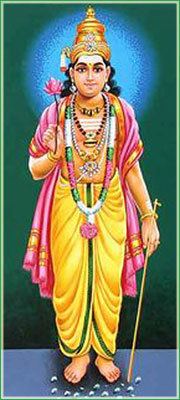 | ||
Similar | ||
Lord shiva temples ponnaar meniyanae sundarar in mazhabaadi
Sundarar (Tamil Cundarar), also known affectionately as Tampiran Tōḻan (Comrade of the Master, meaning Shiva) was an eighth-century poet who was one of the most prominent Nayanars, the Shaiva bhakti (devotional) poets of Tamil Nadu. He was a contemporary of Cheraman Perumal and Kotpuli Nayanar who also figure in the 63 Nayanmars. The songs of praise are called Thiruthondathogai and is the original nucleus around which the Periyapuranam is based. The Periya Puranam, which collects the legends of the Nayanars, starts and ends with him. The hymns of seventh volume of the Tirumurai, the twelve-volume compendium of the poetry of Tamil Shaiva Siddhanta, were composed by him.
Contents
- Lord shiva temples ponnaar meniyanae sundarar in mazhabaadi
- Life
- Compilation
- In temple worship services
- List of temples revered by Sundarar
- References
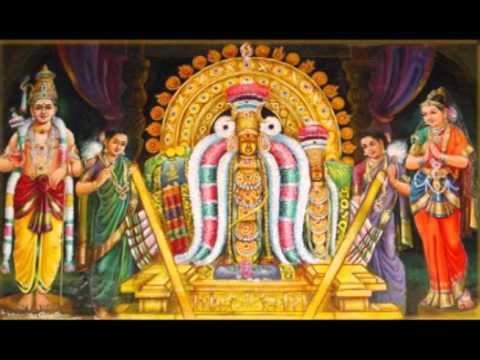
Life
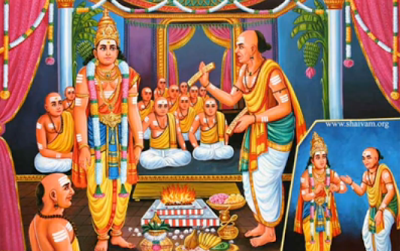
Sundarar is unique among the Nayanars in that both of his parents are also recognised as Nayanars. He was born into an adi saiva, temple priest Brahmin group.His original name was Nambi aroorar. The ruler of the local kingdom (Thirumunaipadi-Nadu), Narasingamunaiarayar a chieftain, adopted him and brought up as his own son, attracted by the beauty of the child he saw playing in the street. Sundarar was a contemporary of great Pallava emperor Rajasimha who was also a nayanmar saint and also author of many devotional hymn works in tamil. A temple inscription in tiruvarur says that sundarar's father sadayan also a nayanmar saint belonged to the gotram or lineage of sage Bharadwaja and his mother isaignani also a nayanmar saint belonged to the gotram or lineage of sage gautama. From epigraphs it is also inferred that a Sanskrit hagiography on sundarar namely sva swami mitra prabhandam translated as travelogues of he who became friend of lord is now not available.
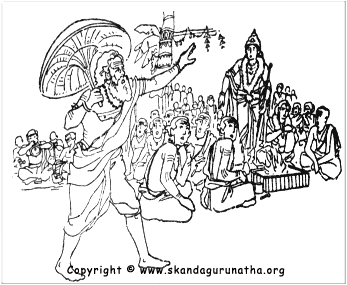
Legend states that while Sundarar was being married, the service was interrupted by an old ascetic who asked for Sundarar as his servant, making a name sake claim that Sundarar's "grandfather pledged him" according to an ancient palm leaf manuscript in his possession. Sundarar and those assembled at the wedding were outraged and called the old man a madman (piththaan: Tamil). But a court of Vedic scholars concluded that the palm leaf was legally valid. Crestfallen, Sundarar resigned himself to servitude in the old man's household and, following him to Thiruvennainallur village, was led to the Thiruvarutturai Shiva temple.
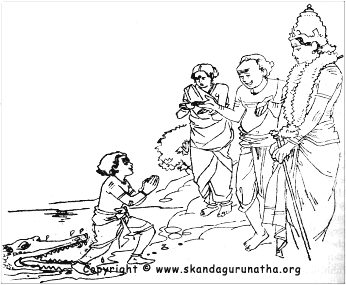
The old man was said to be Shiva (Lord Thiagaraja) himself, who told him: " That the document shown was only a name sake reason and he wanted sundarar to be reminded of his actual form as alalasundarar a servitor in lord's kailasam, who had to be born in earth both due to moments of worldly thoughts that overcame him as well as due to the fact that the southern tamil region that had done great thavam during kali age need be blessed with an account on lives of great nayanmars called tiru thondar thokai.You will henceforth be known as Vanthondan, the argumentative devotee. Did you not call me a mad man just a short while ago? Begin your hymn addressing me 'O mad man!'". Lord sivan had also advised vanthondar to" while on earth sing of us in words of Tamil".
Subsequently, Sundarar moved around Tamil Nadu, visiting several Shiva Temples of Tamil Nadu. In Tiruvarur, in the Thanjavur district, he fell in love with a girl named Paravayar, of the Rudra Kanyakayar caste of female ascetics, and married her. Sundarar was held in such a high regard by his contemporary nayanmar saints like viranmindar, kalikamanar etc. that he was offered royal treatment by those rich servitors. One another nayanmar saint namely kotpuliyar a velalala, praised for some superb services also offers sundarar hand of his daughter but the saint politely declines and instantly picks up the girl and puts in his lap and dedicates a hymn to siva in the end of which he says that he considers the girl equivalent to his daughter. The same treatment is accorded by the saint to yet another girl namely singati. In many hymns sundarar makes this declaration of love filled,gracious patronage to the children that he accorded.
In Thiruvottriyur, a sea-side suburb of Madras, he prayed at the Padampakkanathar/Thyagarajar/Vadivudaiamman Temple, where he saw a farmer's girl, Sangiliyar, who was preparing flower garlands and married her, promising never to leave.
Sundarar is also famous for declaring in many hymns that one reality of lord sivan is apprehended by selfless, dispassionate and attachment free service to him. He also declares that all beings are created equal by lord.
At tirupunkoor near thillai chidambaram a famous saivite temple, the region was devoid of rains for a long time. A local chola prince requested sundarar to address the problem, thereupon the saint put up a wail for justice saying that 12 of land be given to the temple if it rains by his service and upon completing the song to lord sivan rains lashed incessantly. After many such days sundarar was summoned by the prince again to fix the problem of heavy rains. sundarar once again insisted that 12 more acres be given to the temple should the rains cease after his song. The same happened and the temple became richer by 24 acres more.
At avinashi an ancient saiva pilgrim centre near present-day coimbatore sundarar prayed to lord sivan to give back life to an eight-year-old boy who had died untimely many years ago. On hearing his hymn lord sivan bestowed his grace and the boy who was swallowed by a crocodile was instantly returned by the same crocodile.
The legend states that at Tiruvarur he recited the names of all sixty-three future Nayanars: this recitation is called Tiruttondar-Tokai. In it, he refers to himself as the servant of servants of these saints. His fame reached the ears of the Cheraman Perumal, who came to Tiruvarur. Both embarked on a pilgrimage. But Sundarar became tired of life and was taken up to heaven by a white elephant. The king followed him on his horse. This occurred in "Swathi Nakshtra" in the Tamil month of "Aadi".
Compilation
Raja Raja Chola I (985-1013 CE) embarked on a mission to recover the hymns after hearing short excerpts of Tevaram in his court. He sought the help of Nambi Andar Nambi, who was a priest in a temple. It is believed that by divine intervention Nambi found the presence of scripts, in the form of cadijam leaves half eaten by white ants in a chamber inside the second precinct in Thillai Nataraja Temple, Chidambaram. The brahmanas (Dikshitars) in the temple are supposed to have disagreed with the king by saying that the works were too divine, but Rajaraja is said to have prevailed. Rajaraja thus became to be known as Tirumurai Kanda Cholan meaning one who saved the Tirumurai. Thus far Shiva temples only had images of god forms, but after the advent of Rajaraja, the images of the Nayanar saints were also placed inside the temple. Nambi arranged the hymns of three saint poets Campantar, Appar and Sundarar as the first seven books, Manickavasagar's Tirukovayar and Tiruvacakam as the 8th book, the 28 hymns of nine other saints as the 9th book, the Tirumandiram of Tirumular as the 10th book, 40 hymns by 12 other poets as the 10th book, Tirutotanar Tiruvanthathi - the sacred anthathi of the labours of the 63 nayanar saints and added his own hymns as the 11th book. The first seven books were later called as Tevaram, and the whole Saiva canon, to which was added, as the 12th book, Sekkizhar's Periya Puranam (1135 CE) is wholly known as Tirumurai, the holy book. Thus Saiva literature which covers about 600 years of religious, philosophical and literary development.
The earlier pallava dantivarman and kampavarman inscription informs about the singing of tirumurai in temples to the sounding of udukkai(small drum) and talam(cymbals).
In 1921, an English translation of Sundarar's hymns was done by Francis Kingsbury and GE Phillips, both of United Theological College, Bangalore (Edited by Fred Goodwill) and published in a book as Hymns of the Tamil Śaivite Saints, by the Oxford University Press.
In temple worship services
Tirumurai was one of the sole reasons for converting Vedic ritual to Agamic puja followed in Shiva temples. Though these two systems are overlapping, Agamic tradition ensures the perpetuation of the Vedic religion's emphasis on the efficacy of ritual as per Davis. Odhuvars, Sthanikars, or Kattalaiyars offer musical programmes in Shiva temples of Tamil Nadu by singing Tevaram after the daily rituals. These are usually carried out as chorus programme soon after the divine offering. There are records from Kulothunga Chola III from Nallanyanar temple in South Arcot indicating singing of Tiruvempavai and Tiruvalam of Manickavasagar during special occasion in the temple. From the 13th century, the texts were passed on to the Odhuvars by the Adheenams or charitable establishments. The charitable establishments that ran on philanthropy of individuals and merchant caravans had come to be because after the 13th century, the time of ancient nation states viz. cholas etc. was finished and the temples became only denominated, voluntary, charitable places. This is briefed by a 15th-century, chidambaram temple inscription.During the time of cholas etc. the temple hymn service workers were known as uvacchar and marars. These terms are of very ancient origin and traceable to even early sangam times.
Periya Puranam, the 11th-century Tamil book on the Nayanars that forms the last volume of the Tirumurai primarily had references only to Tevaram and subsequently expanded to 12 parts and is one of the first anthologies of Tirumurai. One of the first anthologies of moovars hymns called the Tevara Arulmuraitirattu is linked to Tamil Saiva siddhantha philosophy by grouping ninety-nine verses into 10 categories. The category headings are God, soul, bond, grace, divine intiation, methodology, enlightenment, bliss, mantra and liberation - correspond to Umapthi's work, Tiruvarutpayan. Tirumurai kanda puranam is another anthology for Tirumurai as a whole, but primarily focuses on Tevaram. It is the first of the works to refer the collection of volumes as Tirumurai.
List of temples revered by Sundarar
The Paadal Petra Sthalams are 275 temples that are revered in the verses of Tevaram and are amongst the greatest Shiva temples of the continent. Vaippu Sthalangal are places that were mentioned casually in the songs in Tevaram. The focus of the moovars (first three poets) hymns suggests darshan (seeing and being seen by God) within the puja (worship) offering. The hymnists made classificatory lists of places like katu (for forest), turai (port or refuge), kulam (water tank) and kalam (field) being used - thus both structured and unstructured places in the religious context find a mention in Tevaram. Out of the 275 locations only one is in Kerala at Mahadeva Temple, Thiruvanchikulam.
